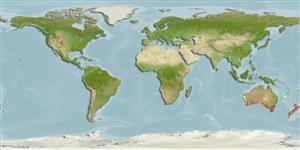Environment: milieu / climate zone / Tiefenbereich / distribution range
Ökologie
seewasser; brackwasser demersal; tiefenbereich 0 - 100 m (Ref. 33839). Subtropical
Eastern Indian Ocean and Southwest Pacific: south coast of Australia; New Zealand (Ref. 5755).
Size / Gewicht / Alter
Geschlechtsreife: Lm ? range ? - ? cm
Max length : 45.0 cm TL Männchen/unbestimmt; (Ref. 9563)
Rückenflossenweichstrahlen (insgesamt) : 56 - 69; Afterflossenweichstrahlen: 40 - 50. Body deep (47-60% SL). Snout slightly extended into fleshy process projecting more or less in front of oblique mouth. Scales very small, rather firmly attached; cycloid on both sides, covering head except well anteriorly. Caudal fin rays 14 -17 (Ref. 33839).
Body shape (shape guide): short and / or deep; Cross section: compressed.
Common on silty sand substrates from estuaries and inshore waters down to 100 m depth. Juveniles occasionally entering rivers.
Life cycle and mating behavior
Geschlechtsreife | Fortpflanzung | Ablaichen | Eier | Fecundity | Larven
Kailola, P.J., M.J. Williams, P.C. Stewart, R.E. Reichelt, A. McNee and C. Grieve, 1993. Australian fisheries resources. Bureau of Resource Sciences, Canberra, Australia. 422 p. (Ref. 6390)
IUCN Rote Liste Status (Ref. 130435: Version 2025-1)
Bedrohung für Menschen
Harmless
Nutzung durch Menschen
Fischereien: kommerziell; Aquakultur: experimental
Tools
Zusatzinformationen
Download XML
Internet Quellen
Estimates based on models
Preferred temperature (Ref.
123201): 11.9 - 18.3, mean 16.6 °C (based on 248 cells).
Phylogenetic diversity index (Ref.
82804): PD
50 = 0.5625 [Uniqueness, from 0.5 = low to 2.0 = high].
Bayesian length-weight: a=0.01820 (0.00790 - 0.04194), b=2.97 (2.76 - 3.18), in cm total length, based on LWR estimates for this (Sub)family-body shape (Ref.
93245).
Trophic level (Ref.
69278): 3.1 ±0.3 se; based on size and trophs of closest relatives
Widerstandsfähigkeit (Ref.
120179): mittel, Verdopplung der Population dauert 1,4 - 4,4 Jahre. (K=0.2; tmax=10).
Fishing Vulnerability (Ref.
59153): Moderate vulnerability (35 of 100).
🛈
Nutrients (Ref.
124155): Calcium = 107 [44, 243] mg/100g; Iron = 1.08 [0.50, 2.26] mg/100g; Protein = 18.1 [16.6, 19.6] %; Omega3 = 0.212 [0.104, 0.434] g/100g; Selenium = 38.1 [17.5, 93.5] μg/100g; VitaminA = 3.74 [0.87, 17.31] μg/100g; Zinc = 0.728 [0.467, 1.155] mg/100g (wet weight);
